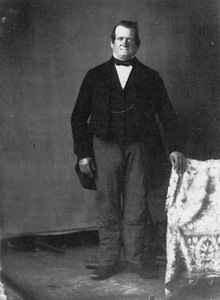
Orson Hyde |

Orson Hyde (1805-1878), about 1853. He accepted the gospel in 1831 in Kirtland, Ohio, and was ordained an apostle in 1835. He was called to go to Jerusalem in 1840, and on October 24, 1841, dedicated the Holy Land for the gathering of Israel. Attributed to Marsena Cannon.
by Howard H. Barron
As a member of the first Twelve Apostles (1835) of the modern dispensation and the first missionary to take the message of the restored gospel to continental Europe and the Near East, Orson Hyde was closely allied with the rise and the development of the LDS Church. Born on January 8, 1805, in Oxford, New Haven County, Connecticut, he was raised in the care of Nathan Wheeler of Derby, Connecticut. In 1819, Hyde walked some six hundred miles to the town of Kirtland, Ohio, where Wheeler had purchased land. There he found employment as a clerk in the N. K. Whitney & Co. store. Continuously searching for deeper religious truths, he came under the influence of Sidney Rigdon, a Reformed Baptist minister, and embraced restorationist ideals advanced by Alexander Campbell and Sidney Rigdon.
When Oliver Cowdery and other missionaries to the Lamanites came through the Kirtland region in October-November 1830, Orson spoke against the "Mormon Bible," a position he changed after carefully examining the Book of Mormon. After three months of studying and pondering the doctrines taught by the Latter-day Saints, he was baptized in the Chagrin River on October 30, 1831, by Sidney Rigdon, who also had been converted (Barron, pp. 15-25).
A succession of missions followed Hyde's conversion. He and Hyrum Smith preached in Elyria and Florence, Ohio, and in 1832 he joined Samuel Smith in journeying to the "eastern countries" of the United States. In 1833 he and John Gould were sent as Church emissaries to resolve difficulties in Jackson County, Missouri. He marched with Zion's Camp the following year. After returning to Ohio, he married Nancy Marinda Johnson in Kirtland, on September 4, 1834.
On February 15, 1835, Orson Hyde was ordained a member of the Quorum of the Twelve Apostles, and in 1837 he represented the Church in petitioning the Ohio state legislature for a bank charter for the Kirtland Safety Society. He went with Heber C. Kimball on the first mission to Great Britain (1837-1838). Their work led to the eventual conversion of thousands to the Mormon faith (see Missions of the Twelve to the British Isles).
Hyde was in Far West, Missouri, by the summer of 1838, and in October he signed an affidavit against the Saints during the severe persecution of that period. John Taylor said that perhaps Hyde "had been sick with a violent fever" (HC 3:168). Whatever the reason, Hyde made things right with Joseph Smith and in the spring of 1839 wrote to the Twelve in Illinois asking if he could return. Dropped from the Quorum of the Twelve on May 4, 1839, he was again sustained as an apostle on June 27, 1839.
Years before, it had been prophesied that Hyde "had a great work to perform among the Jews" (HC 4:106), and in 1840 he was directed to undertake a mission that took him to New York, London, Amsterdam, Constantinople (Istanbul), and Jerusalem, speaking to the Jewish communities wherever he could. On October 24, 1841, Elder Hyde climbed the Mount of Olives near Jerusalem and offered a prophetic prayer of dedication, asking the Lord to remove the "barrenness and sterility of this land" (Hyde, p. 21). He returned home via Cairo, Alexandria, Trieste, and Germany. In Germany he published the first LDS German tract, Ein Ruf aus der Wüste (A Cry out of the Wilderness; Frankfurt, 1842).
When the majority of the Saints left Nauvoo for Iowa Territory early in 1846, Orson Hyde was asked to remain behind to supervise the completion and dedication of the Nauvoo Temple. Dedicatory services were conducted on April 30 and May 1, 1846. From 1846 to 1847 he presided over the British mission. When President Brigham Young returned to the Salt Lake Valley in 1848, Hyde was placed in charge of the camps of Israel in the Midwest. He remained in Kanesville (Council Bluffs, Iowa) until 1852, publishing the Frontier Guardian (1849-1852).
In Utah, Elder Hyde was called to head the Carson Valley Nevada Mission in 1855. He returned to Salt Lake in 1857 because of the Utah expedition. Further implementing his plan to have the Twelve Apostles preside over designated settlement areas, President Young called Elder Hyde to supervise settlement in the Sanpete-Sevier district of Utah in 1858.
At a meeting of the Twelve Apostles held in 1875, Brigham Young made a decision affecting Hyde's standing as the senior member of the Quorum. It was ruled that since he and Orson Pratt had briefly separated themselves from the Quorum in 1838 and 1842, respectively, they should lose their seniority to Elders John Taylor, Wilford Woodruff, and George A. Smith, who had been ordained during their time away (Durham, Succession in the Church [Salt Lake City, 1970], pp. 73-76). Because of that decision, John Taylor rather than Orson Hyde succeeded Brigham Young as President of the Church.
Following a lingering illness, Orson Hyde died at his home in Spring City, Utah, on November 28, 1878. With his passing the Church lost a noted missionary, colonizer, eloquent speaker, and devoted servant.
(See Daily Living home page; Church History home page; People in Church History home page)
Bibliography
Barron, Howard H. Orson Hyde, Missionary, Apostle, Colonizer. Bountiful, Utah, 1977.
Hill, Marvin S. "An Historical Study of the Life of Orson Hyde, Early Mormon Missionary and Apostle from 1805-1852." Master's thesis, Brigham Young University, 1955.
Hyde, Orson. A Sketch of the Travels and Ministry of Elder Orson Hyde. Salt Lake City, 1869.
Encyclopedia of Mormonism, Vol. 2, Hyde, Orson
Copyright © 1992 by Macmillan Publishing Company
All About Mormons |